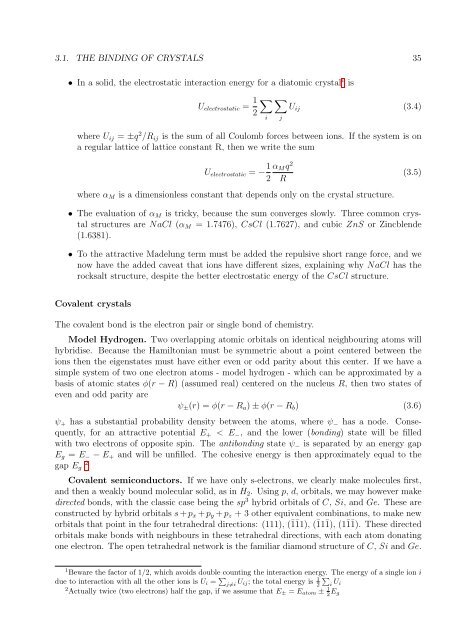Set of supplementary notes.
Set of supplementary notes.
Set of supplementary notes.
Create successful ePaper yourself
Turn your PDF publications into a flip-book with our unique Google optimized e-Paper software.
3.1. THE BINDING OF CRYSTALS 35<br />
• In a solid, the electrostatic interaction energy for a diatomic crystal 1 is<br />
U electrostatic = 1 ∑ ∑<br />
U ij (3.4)<br />
2<br />
where U ij = ±q 2 /R ij is the sum <strong>of</strong> all Coulomb forces between ions. If the system is on<br />
a regular lattice <strong>of</strong> lattice constant R, then we write the sum<br />
i<br />
j<br />
U electrostatic = − 1 α M q 2<br />
2 R<br />
where α M is a dimensionless constant that depends only on the crystal structure.<br />
(3.5)<br />
• The evaluation <strong>of</strong> α M is tricky, because the sum converges slowly. Three common crystal<br />
structures are NaCl (α M = 1.7476), CsCl (1.7627), and cubic ZnS or Zincblende<br />
(1.6381).<br />
• To the attractive Madelung term must be added the repulsive short range force, and we<br />
now have the added caveat that ions have different sizes, explaining why NaCl has the<br />
rocksalt structure, despite the better electrostatic energy <strong>of</strong> the CsCl structure.<br />
Covalent crystals<br />
The covalent bond is the electron pair or single bond <strong>of</strong> chemistry.<br />
Model Hydrogen. Two overlapping atomic orbitals on identical neighbouring atoms will<br />
hybridise. Because the Hamiltonian must be symmetric about a point centered between the<br />
ions then the eigenstates must have either even or odd parity about this center. If we have a<br />
simple system <strong>of</strong> two one electron atoms - model hydrogen - which can be approximated by a<br />
basis <strong>of</strong> atomic states φ(r − R) (assumed real) centered on the nucleus R, then two states <strong>of</strong><br />
even and odd parity are<br />
ψ ± (r) = φ(r − R a ) ± φ(r − R b ) (3.6)<br />
ψ + has a substantial probability density between the atoms, where ψ − has a node. Consequently,<br />
for an attractive potential E + < E − , and the lower (bonding) state will be filled<br />
with two electrons <strong>of</strong> opposite spin. The antibonding state ψ − is separated by an energy gap<br />
E g = E − − E + and will be unfilled. The cohesive energy is then approximately equal to the<br />
2<br />
gap E g<br />
Covalent semiconductors. If we have only s-electrons, we clearly make molecules first,<br />
and then a weakly bound molecular solid, as in H 2 . Using p, d, orbitals, we may however make<br />
directed bonds, with the classic case being the sp 3 hybrid orbitals <strong>of</strong> C, Si, and Ge. These are<br />
constructed by hybrid orbitals s + p x + p y + p z + 3 other equivalent combinations, to make new<br />
orbitals that point in the four tetrahedral directions: (111), (¯1¯11), (¯11¯1), (1¯1¯1). These directed<br />
orbitals make bonds with neighbours in these tetrahedral directions, with each atom donating<br />
one electron. The open tetrahedral network is the familiar diamond structure <strong>of</strong> C, Si and Ge.<br />
1 Beware the factor <strong>of</strong> 1/2, which avoids double counting the interaction energy. The energy <strong>of</strong> a single ion i<br />
due to interaction with all the other ions is U i = ∑ j≠i U ij; the total energy is 1 ∑<br />
2 i U i<br />
2 Actually twice (two electrons) half the gap, if we assume that E ± = E atom ± 1 2 E g








